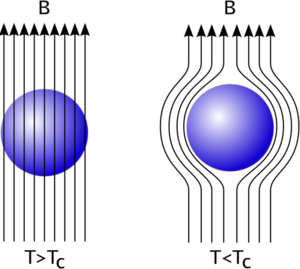Superconductor
A superconductor is a material that has absolutely no electrical resistance (0 Ω) and interesting interactions with magnetic fields. Because of this, it can transmit electricity without producing any waste heat. This material must be cooled below the critical temperature, which is usually very cold. For most materials the critical temperature is a few Kelvin (a few degrees above absolute zero). Some materials have a critical temperature as high as 125K or so (-148°C, much colder than even cold parts of Canada!). While these materials may have uses in energy storage (see for example superconducting magnetic energy storage), it's unlikely that they will be used for transmitting electricity over long distances on the electrical grid anytime soon, due to the difficulty of cooling thousands of kilometers of transmission lines.
Oddly, superconductors above their critical temperatures are often not even conductors.
For more information on this fascinating subject please see hyperphysics, specifically the articles on high temperature superconductors.


